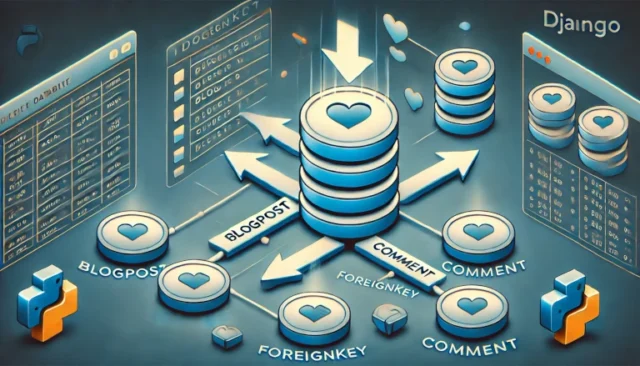In Django and Django REST Framework (DRF), data modeling is a crucial part of building robust applications. One of the most common relationships you will encounter is the many-to-one relationship, which is implemented using Django’s ForeignKey field. This type of relationship is essential for modeling scenarios where multiple records in one model are related to a single record in another model. In this post, we will explain what a many-to-one relationship is, how it works, and how to implement it using ForeignKey in Django. We will also cover common issues and their solutions to make your development experience smoother.
Whether you’re new to Django or an experienced developer looking to understand the details, this comprehensive guide will help you master many-to-one relationships.
What is a Many-to-One Relationship?
A many-to-one relationship in a database occurs when multiple records in one table are linked to a single record in another table. For example, consider a blog application where each post can have multiple comments, but each comment is related to only one post. This is a classic many-to-one scenario:
- BlogPost (one side)
- Comment (many side)
In Django, we use the ForeignKey field to represent this type of relationship.
- One-to-Many Example: One blog post can have many comments, but each comment is associated with only one post.
- Common Usage: Many-to-one relationships are commonly used in applications to establish relationships like author-post, category-product, or department-employee.
How to Implement Many-to-One Relationship Using ForeignKey in Django
Step 1: Define the Models
To implement a many-to-one relationship, we start by defining two models and using the ForeignKey field to establish the connection. Let’s consider an example with a blog post and comments.
from django.db import models
class BlogPost(models.Model):
title = models.CharField(max_length=100)
content = models.TextField()
def __str__(self):
return self.title
class Comment(models.Model):
post = models.ForeignKey(BlogPost, on_delete=models.CASCADE, related_name='comments')
author = models.CharField(max_length=50)
text = models.TextField()
created_at = models.DateTimeField(auto_now_add=True)
def __str__(self):
return f"Comment by {self.author}"In this example:
BlogPost: Represents the blog post model.Comment: Represents the comment model, which has a ForeignKey toBlogPost.post = models.ForeignKey(BlogPost, on_delete=models.CASCADE, related_name='comments'): This line creates the many-to-one relationship where multiple comments belong to a single blog post.on_delete=models.CASCADE: Ensures that when a blog post is deleted, all associated comments are also deleted.related_name='comments': Allows accessing all comments related to a particular blog post usingpost.comments.all().
How Does ForeignKey Work in Django?
The ForeignKey field in Django helps link one model to another. It represents a many-to-one relationship by creating a reference between two tables in the database.
on_deleteBehavior: Theon_deleteparameter defines what happens to the related objects when the referenced object is deleted. Common options are:models.CASCADE: Deletes all related objects.models.PROTECT: Prevents deletion of the referenced object.models.SET_NULL: Sets the related field toNULL.related_nameAttribute: Therelated_nameattribute provides a way to access the related objects in a reverse relationship. For example, you can access all comments for a specific post withpost.comments.all().
Setting Up the Views and Serializers in Django REST Framework
If you are using Django REST Framework (DRF), you may also want to expose these models through an API. Below is an example of how to set up views and serializers for the BlogPost and Comment models.
Serializers
from rest_framework import serializers
from .models import BlogPost, Comment
class CommentSerializer(serializers.ModelSerializer):
class Meta:
model = Comment
fields = ['id', 'post', 'author', 'text', 'created_at']
class BlogPostSerializer(serializers.ModelSerializer):
comments = CommentSerializer(many=True, read_only=True)
class Meta:
model = BlogPost
fields = ['id', 'title', 'content', 'comments']In this example, the BlogPostSerializer includes a nested representation of comments, which makes it easier to access all related comments for each blog post.
Views
from rest_framework import viewsets
from .models import BlogPost, Comment
from .serializers import BlogPostSerializer, CommentSerializer
class BlogPostViewSet(viewsets.ModelViewSet):
queryset = BlogPost.objects.all()
serializer_class = BlogPostSerializer
class CommentViewSet(viewsets.ModelViewSet):
queryset = Comment.objects.all()
serializer_class = CommentSerializerThe viewsets allow you to create, read, update, and delete blog posts and comments via API endpoints.
Common Issues and How to Solve Them
Issue: IntegrityError Due to ForeignKey Constraint
If you attempt to delete a BlogPost object that has related Comment objects without specifying on_delete=models.CASCADE, you might run into an IntegrityError.
Solution: Ensure you correctly use the on_delete parameter. If you want to delete all related objects, use models.CASCADE.
Issue: Related Field Not Showing Up in API
If the related field does not show up in the API, it might be due to incorrect serialization.
Solution: Use related_name to properly reference related objects and ensure they are included in the serializer with many=True and read_only=True.
Best Practices for Using ForeignKey in Django
- Use Descriptive Related Names: Use descriptive names for
related_nameto make your code more readable. For example, use'comments'instead of something generic like'related_objects'. - Choose the Right on_delete Option: Depending on your business logic, choose the appropriate
on_deletebehavior to avoid unexpected data loss. - Optimize Queries: Use
select_related()orprefetch_related()to optimize queries when fetching related objects to avoid performance bottlenecks.
Conclusion
Understanding and implementing many-to-one relationships using ForeignKey in Django is crucial for building relational data models. By properly defining your models and understanding how to use related fields, you can create complex data structures that reflect real-world scenarios. This guide has provided an in-depth explanation of how to set up and use ForeignKey fields in Django, along with best practices and solutions to common issues.
Start using ForeignKey today to enhance the functionality of your Django applications and create efficient, scalable data models!
